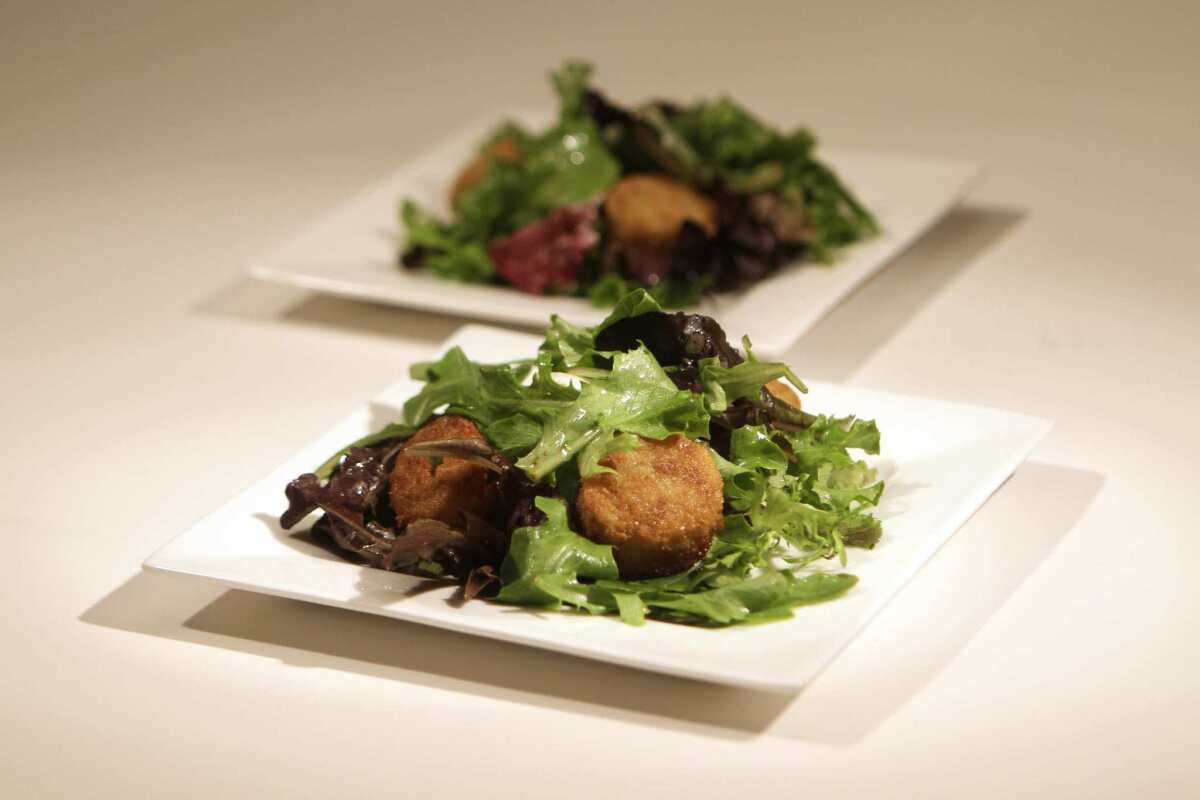Recipe: Marrow croutons

Jennifer McLagan has a knack for tackling topics that are, shall we say, “under-appreciated”. To complete a “trilogy” of sorts, the author follows up her award-winning “Bones” and “Fat” with “Odd Bits: How to Cook the Rest of the Animal.” Full-on nose-to-tail eating, she leaves nothing uncovered, and no scrap unused.
Wonderfully thorough, McLagan knows her subject inside and out, and she explores every last tidbit from almost every animal imaginable, from cockscombs to testicles. Ever want to know how to eat an eyeball? She’ll walk you through it. But instead of approaching the reader from a shocking or even a clinical standpoint, she is more like a reassuring schoolteacher handling a timid student.
She broaches what most might consider tough subjects, like cooking the head of an animal, approaching various organs, or how to use blood, but helps us wade into unfamiliar territory gently and slowly to lessen any anxiety. Many of the chapters start with recipes for “newbies,” such as “Beginner’s Tripe” and “Headcheese for the Unconvinced,” and she often includes substitute ingredients if you don’t have, or are anxious about using, the star ingredient.
As she explores various ingredients, McLagan intersperses practical knowledge, like where to find the part and what to look for, with fun tidbits and history. I never knew that the Chinese prize the feet from American chickens (because Americans prefer white meat, larger-breasted hens are bred making for bigger birds — bigger birds need better support, hence jumbo feet).
And unless you’re the most ardent vegetarian, you can’t help but be drawn in by at least some of the recipes. I haven’t yet tried the recipes for chocolate blood ice cream, or the heart tartare, but I loved the chicken liver crostini and the twice-cooked beer belly. Her salad with warm bone marrow croutons is a recipe I’ll be making again and again, with rich — almost buttery — bone marrow medallions coated with bread crumbs and pan-fried until melting, then tossed with a salad of tart greens and bright raspberry vinaigrette. And if you’ve never had bone marrow, this is a great introduction — after all, doesn’t everything taste better breaded and pan-fried?
“Odd Bits: How to Cook the Rest of the Animal” by Jennifer McLagan, Ten Speed Press, $35.
— Noelle Carter
Salad with warm bone marrow croutons
Total time: 1 hour, 15 minutes, plus soaking time for the marrow
Servings: 4 to 6
Note: Adapted from “Odd Bits: How to Cook the Rest of the Animal” by Jennifer McLagan. About bone marrow, she writes, “Veal and beef marrow are the most common; calf and cow and their leg bones contain the most marrow. They can be cut to any length you want; ask your butcher for pieces cut from the center of the leg bone, where the ratio of marrow to bone is highest. Make sure the marrow is accessible at both ends of the bone, especially if you plan on extracting the marrow before cooking. It is hard to judge how much marrow you will get from any bone, and it ranges widely depending on the thickness of the bone: a 3-inch bone will yield anywhere from 3/4 to 3 ounces, but usually it averages around 1 1/2 ounces. Buy extra bones to be sure you have enough.” Have the bones cut crosswise into pieces one-half inch thick for this recipe. You can also purchase longer bones; have longer bones cut lengthwise to make the marrow easier to extract, then slice the marrow crosswise into one-half inch slices.
Extracting and soaking the marrow
About 2 1/2 pounds center cut beef or veal leg bones, cut crosswise into 1/2-inch slices
Coarse sea salt
1. Leave the marrow bones on the counter at room temperature for about 15 minutes; the marrow should just begin to soften slightly. Now run a small, flexible knife between the marrow and bone at each end, to free the marrow from the bone as much as possible. Pick up the bone and, using your thumb, push the marrow from the thin end toward the fat end out of the bone. Don’t start at the thick end. The marrow will be soft and will tend to squish under the force of your thumb, but persist and eventually the marrow will emerge from the bone in one piece. If the bones are cut lengthwise, run a knife along either edge of the cut bone, and set aside at room temperature until slightly softened, then ease the marrow out.
2. To remove the blood from the marrow, place the extracted marrow in a bowl of ice water with 1 teaspoon of coarse sea salt per cup. Refrigerate for 12 to 24 hours, changing the water 4 to 6 times and replacing the salt each time. Drain and refrigerate until you are ready to cook the marrow. Use within 24 hours or freeze the drained marrow bones or marrow for up to 3 months.
Haralds’ vinaigrette
1 tablespoon raspberry syrup
1 tablespoon Dijon mustard
1 tablespoon balsamic vinegar
1 teaspoon wine vinegar
Coarse sea salt and freshly ground black pepper
3/4 cup extra-virgin olive oil
1/2 clove garlic, crushed
In a glass measuring cup, whisk together the raspberry syrup, Dijon mustard, and vinegars. Season with salt and pepper and slowly whisk in the olive oil. Add the garlic clove and whisk again. This makes about 1 cup vinaigrette, more than is needed for the remainder of the recipe; the vinaigrette will keep, covered and refrigerated, up to 3 days.
Salad and assembly
About 5 ounces cold bone marrow slices, extracted and soaked
Fine sea salt and freshly ground black pepper
1/4 cup flour
1 egg, beaten
1 teaspoon mustard powder
2/3 cup fresh bread crumbs
Olive oil or lard
10 to 12 cups mixed salad greens
Haralds’ vinaigrette
1. Season the sliced marrow pieces lightly with salt and pepper.
2. Prepare 3 shallow dishes: 1 with the flour, 1 with the egg, and 1 with the bread crumbs. Season the beaten egg with salt and pepper and mix the mustard powder into the bread crumbs.
3. Dip the seasoned marrow slices into the flour, then the egg, and finally the bread crumbs, making sure each piece is very well coated with crumbs. If the marrow isn’t well coated, it may melt as it cooks. Keep the marrow cool; if your kitchen is warm or your hands are too hot, the marrow will begin to soften. Return the bread crumbed marrow slices to the refrigerator to firm up.
4. Heat the oven to 200 degrees. Place a baking sheet lined with paper towels in the oven.
5. Set a small frying pan over medium heat and pour in enough olive oil to cover the bottom of the pan. When the oil is hot, add half of the marrow and cook until golden brown on both sides, about 2 minutes per side. Transfer to the baking sheet, sprinkle with salt, and keep warm in the oven.
6. Drain the fat from the pan, wipe it clean, and pour in more olive oil to fry the second batch of marrow. Transfer to the baking sheet and sprinkle with salt.
7. Trim, rinse and spin dry the salad greens, and then place them in a large salad bowl. Toss the greens with enough of the vinaigrette to coat. Divide the salad between the plates and top with the warm marrow croutons.
Each of 6 servings: 442 calories; 4 grams protein; 13 grams carbohydrates; 3 grams fiber; 42 grams fat; 3 grams saturated fat; 31 mg cholesterol; 4 grams sugar; 108 mg sodium.
More to Read
Eat your way across L.A.
Get our weekly Tasting Notes newsletter for reviews, news and more.
You may occasionally receive promotional content from the Los Angeles Times.






